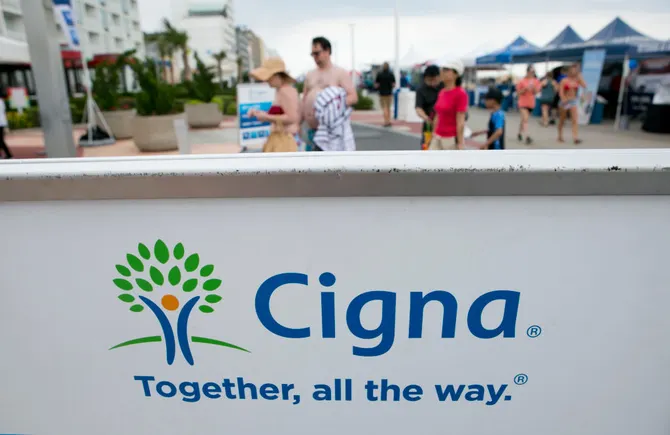Dive Brief:
Cigna is building on client demand for tools to support patients on GLP-1 weight loss drugs, announcing two new programs on Friday meant to improve clinical care around the dispensing of GLP-1s and provide home delivery of the medications.
The programs come as payers that contract with Cigna’s massive pharmacy benefit manager Express Scripts for their drug benefits want to offer GLP-1s but are put off by the medications’ steep list prices and unpredictable long-term outcomes, according to Cigna.
The programs were announced in tandem with Cigna’s first quarter results, which came in well above analysts’ expectations. Revenue of $65.5 billion was up more than 14% year over year, while net income of $1.3 billion compares to a loss of $277 million same time last year. Cigna raised its 2025 profit outlook following the results.
Dive Insight:
Fresh off of reshuffling its C-suite and following a turbulent year for health insurers and pharmacy benefit managers, Cigna is doubling down on a reliable growth area: assuaging client concerns around covering GLP-1s, medications that have shown clear efficacy in helping patients shed pounds but can cost more than $1,000 each month.
High list prices, coupled with the fact that many patients go off the medications and regain lost weight, have created an unclear return on investment for payers. However, employers and insurers are still looking for avenues to provide GLP-1s to their members, given steep consumer demand.
Cigna’s strategy is to provide wraparound programs to help patients make lifestyle changes to ensure any health benefits from GLP-1s stick, and provide financial guarantees to protect payers from unexpected GLP-1 cost hikes.
Evernorth’s initial program, called EncircleRx, launched early 2024 and has since ramped to cover 9 million patients, Cigna executives said on a Friday morning call with investors.
Now, Evernorth is introducing EnReachRx, a GLP-1 support program that leans on pharmacists to optimize doses, detect any fraud or waste and help consumers manage any side effects; and EnGuide Pharmacy, a home delivery pharmacy that specializes in GLP-1s. Both programs will go live next month.
“We saw an opportunity to create new value in the GLP-1 space through the combination of addressing access, affordability, clinical safety and long-term lifestyle changes,” Cigna COO Brian Evanko said on the call.
Evanko sought to differentiate Cigna’s approach to GLP-1s from tactics taken by other PBMs to help clients manage surging costs while increasing patient access.
CVS, which owns PBM Caremark, announced on Thursday that it had inked a deal with Danish drugmaker Novo Nordisk, which manufactures the GLP-1 Wegovy, to give Wegovy preferred placement on its standard formulary.
That means Wegovy will be available to Caremark members at a lower price, but that other GLP-1s, such as Eli Lilly’s Zepbound, could be more expensive.
“We don’t necessarily see formulary placement or choosing one drug over another in this class as being sufficient to generate the societal impact that these drugs can have,” Evanko said, adding that competition, including among drugmakers and different brands of medications, “tends to improve affordability.”
Overall, Evernorth brought in $1.4 billion in adjusted income from operations in the quarter, up 5% year over year.
Growth in the division’s specialty and care business, which includes Evernorth’s specialty pharmacy Accredo, was especially strong, with revenue swelling 19% year over year in the quarter — well above analyst expectations.
The specialty segment also accounted for 30% of Cigna’s entire income in the quarter, according to Evanko.
Cigna chalked the growth in part up to increased adoption of biosimilars for Humira, AbbVie’s blockbuster drug that treats a variety of inflammatory conditions like arthritis and Crohn’s disease.
Offering the copycats is potentially a quite lucrative play for Evernorth, giving the growing addressable market and that switching members to biosimilars is generally more profitable for Accredo.
This month, Accredo also began offering a biosimilar for immunosuppressant Stelara, also at $0 out of pocket for eligible patients.
Cigna executives cautioned investors that the new offering may not take off at the same rate as the Humira biosimilars but should bolster Evernorth’s earnings over time.
“Each biosimilar will have different rates of adoption,” Evanko said. “But that said we do expect to see gradual growth in Stelara biosimilars over the balance of the year … and we expect a further step up in 2026.”
Meanwhile, Cigna Healthcare, the company’s health insurance division covering 18 million members, reported adjusted income from operations of $1.3 billion, down 4% year over year despite premium rate increases meant to cover higher medical costs.
Its medical loss ratio, a key marker of spending on patient care, was 82.2%, compared to 79.9% same time last year.
Executives chalked the increase up to higher costs in Cigna’s stop-loss insurance segment that first hit the payer in the fourth quarter.
Stop-loss insurance protects self-funded employers from health insurance costs above a certain amount. More workers utilizing pricey specialty medications and receiving high-acuity surgeries drove stop-loss costs significantly higher for Cigna, though the company is making progress on initiatives to improve margins starting in the back half of 2025, Evanko said.
In addition, Cigna’s $3.7 billion sale of its Medicare business to Health Care Service Corporation closed later than expected in the quarter, saddling Cigna with that business’ higher costs and moderately boosting its MLR.
But overall, medical costs were elevated but not more than the insurer had predicted, Cigna CFO Amy Dennison said. Cigna’s MLR was around what analysts had expected, while the division’s income was better.
It was Dennison’s first earnings call with investors after being appointed to the CFO role in March.


